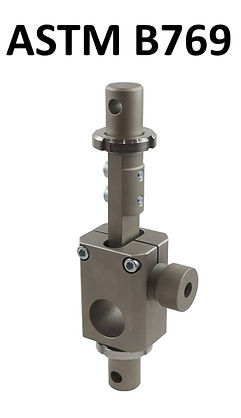ASTM B769
Shear Testing Aluminum Alloys

 |
|---|
 |
 |
 |
 |
ASTM Standard Test Method for Shear Testing of Aluminum Alloys - PDF
ASTM B769 – Shear Strength of Aluminum Alloys with the Amsler Double-Shear Fixture
🔍 Scope
ASTM B769 describes a standard method for measuring the shear strength of wrought and cast aluminum products using a double-shear test. The purpose is to determine the ultimate shear strength—the maximum stress the material can withstand before fracturing in shear. The method is highly relevant for aluminum alloys used in structural and aerospace applications.
🧪 Application
This test helps engineers and designers:
-
Evaluate aluminum materials for high-performance uses such as aircraft structures and aerospace fasteners.
-
Determine minimum material properties for design and certification.
-
Simulate real-world conditions where materials experience complex loads, not just “pure shear,” which rarely occurs in service.
⚠️ Note: Shear strengths from ASTM B769 are generally about 10% higher than ASTM B565, so results from the two methods should not be interchanged.
🧰 Brief Summary of Procedure
-
A cylindrical specimen is placed inside a double-shear fixture, such as the Amsler shear fixture.
-
The fixture is loaded in tension or compression using a universal testing machine.
-
The load is applied across two shear planes until the specimen fractures.
-
The maximum load is recorded, and the shear strength is calculated.
🧷 The Amsler Shear Fixture (Key Component)
The Amsler shear fixture is the most common fixture for ASTM B769 testing. It is a double-shear tool designed to ensure precise alignment and uniform loading across both shear planes.
-
Design: The fixture typically consists of two hardened steel dies with precision-machined edges, supported by a robust frame. The dies apply force simultaneously at two locations on the specimen.
-
Material: Made of tool steel, hardened to Rockwell 60–62 HRC, to withstand repeated high-stress testing without deformation.
-
Functionality: By loading the specimen in double shear, the Amsler fixture distributes forces evenly, reducing bending effects and ensuring results reflect shear strength, not other failure modes.
-
Advantages:
-
High repeatability and accuracy.
-
Minimizes off-axis forces due to its rigid alignment.
-
Long service life in demanding aerospace and industrial labs.
-
The Amsler fixture has become the industry standard tool for ASTM B769, ensuring consistency across labs worldwide.
📐 Orientation & Direction
Shear strength varies depending on grain direction in aluminum. Specimen orientation is identified with two-letter codes:
-
First letter: direction normal to shear plane
-
Second letter: direction of applied load
-
Examples: L-S, T-S for plate; L-R, C-R for rods
-
⚙️ Test Procedure
-
Clean specimen and dies (acetone recommended).
-
Insert specimen into the Amsler shear fixture.
-
Apply load at ≤ 0.75 in/min crosshead speed.
-
Record the maximum load at shear fracture.
-
Clean dies after each test to remove aluminum buildup.
📊 Shear Strength Calculation
S=2PmaxπD2S = \frac{2P_{max}}{\pi D^2}S=πD22Pmax
Where:
-
PmaxP_{max}Pmax = maximum load before fracture
-
DDD = specimen diameter
📝 What to Report
Your lab report must include:
-
ASTM B769 test method reference
-
Material and sample ID
-
Specimen diameter and orientation
-
Maximum load (lbf or N)
-
Calculated shear strength (ksi or MPa)
-
Test temperature
-
Fixture type (Amsler shear fixture recommended)
🔧 Why the Amsler Fixture Matters
The accuracy of ASTM B769 depends heavily on the fixture design. The Amsler shear fixture provides:
-
Precise double-shear loading, minimizing bending stresses.
-
Consistent alignment, essential for aerospace-grade aluminum evaluation.
-
Standardization, since many test labs worldwide rely on this fixture, ensuring comparable results across facilities.
🗂️ In Summary
ASTM B769 provides a consistent way to measure the ultimate shear strength of aluminum alloys using a double-shear fixture, most commonly the Amsler shear fixture. The method delivers reliable, reproducible results essential for aerospace, defense, and structural engineering. By using the Amsler fixture, labs ensure their data meets both ASTM requirements and industry expectations for accuracy and reliability.

